The article below by Richard Grey entitled “Riddle of the medieval ‘mummy’ discovered in Siberia: Child from unknown Arctic civilization found wrapped in birch bark” originally appeared in the Daily Mail on July 6, 2015.
The article is of interest as it pertains to the remains of a child or teenager from the 12th or 13th centuries CE. The Body was discovered at the medieval site near Salekhard in Russia, near Arctic Circle.
Five other bodies found previously at the site were covered in copper plates.These are thought to have been part of a civilization with links to Persia.
================================================
The remains of a medieval ‘mummy’ wrapped in a cocoon of birch bark has been discovered at the site of a village that belonged to a mysterious arctic civilization.
Archaeologists discovered the remains, which they believe may be a child or teenager from the 12th or 13th century, while excavating near the town of Salekhard in Tyumen Oblast, Russia.
The site, which is 18 miles south of the Arctic Circle, is thought to be a medieval necropolis where several bodies have been buried in ways unlike anything else found in the region.
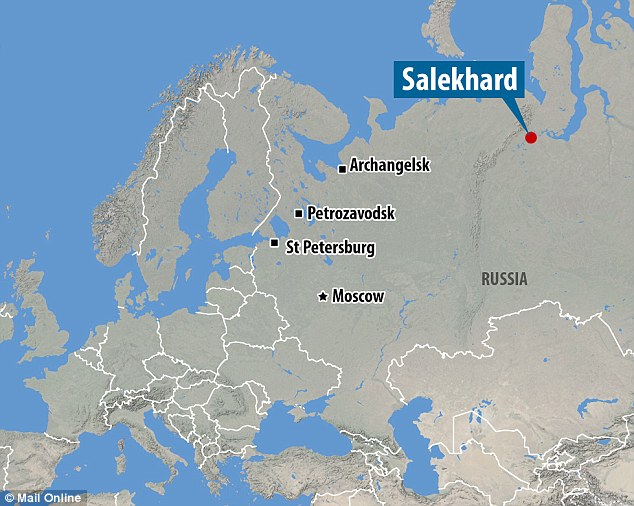
The Zeleny Yar necropolis was found just outside Salekhard in Russia, just 18 miles from the Arctic Circle (Source: Daily Mail Online).
Experts say bodies found at the site appear to have been naturally mummified in the permafrost as a result of being buried with sheets of copper in their shrouds and frozen conditions.
Archaeologists have now removed the latest body to be discovered from the sandy soil, which is now only frozen for part of the year – it is the first human remains to be found since 2002.
The remains, which are being kept in a special freezer in the Shemanovsky Museum in Salekhard, are due to be examined next week.
The birth bark cocoon is around 1.3 metres (4 feet) long and 30cm (12 inches) wide and initial examination has revealed there is metal beneath the birch bark.
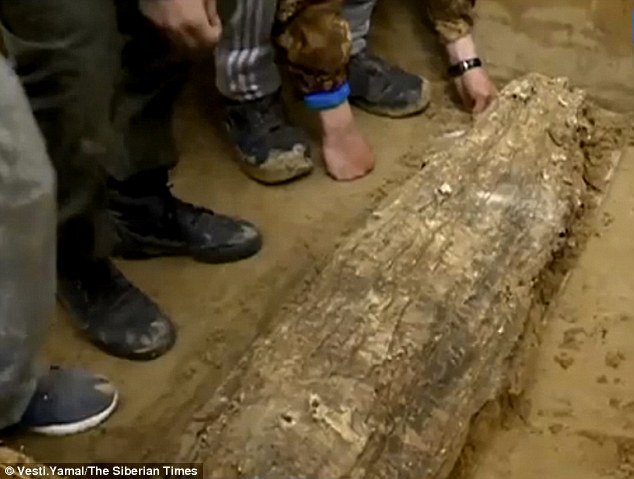
The human remains, which were found wrapped in a birch bark ‘cocoon’ shown above, are thought to have been mummified by a combination of copper buried with the body and the freezing permafrost (Photo source: Vesti Yamal, The Siberian Times). Archaeologists have removed the body in its wrappings from the sandy soil so it can be examined at in Salekhard, Russia.
Experts say it is likely the body inside has been mummified much like others found at the site.
Alexander Gusev, a fellow of the Research Centre for the Study of the Arctic in Russia who led the excavation, told the Siberian Times the birch bark cocoon appeared to have been wrapped around the body. He said:
“It follows the contours of the human body. If there is really a mummy, the head and skull are likely to be in good condition. We think it is a child, maybe a teenager. The find is now in Salekhard, in the Shemanovsky Museum, in special freezer. We plan to return to Salekhard on 15 July and immediately start the opening of the ‘cocoon’ “.
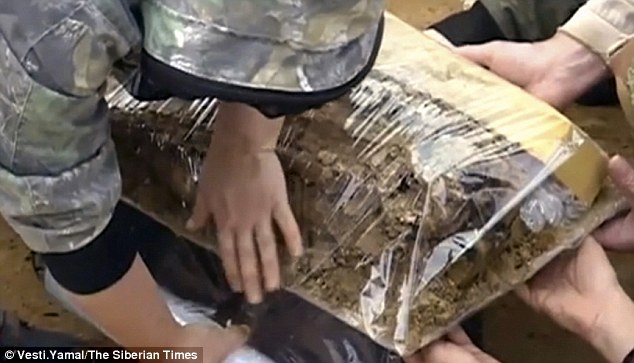
The mummified remains are the first to be uncovered at the site since 2002 and were carefully removed so they could be preserved, as shown above. Scientists hope to open the bark cocoon soon (Photo source: Vesti Yamal, The Siberian Times).
The mummy was discovered at the site of a medieval necropolis called Zeleny Yar, which has baffled some archaeologists due to its closeness to the Arctic Circle.
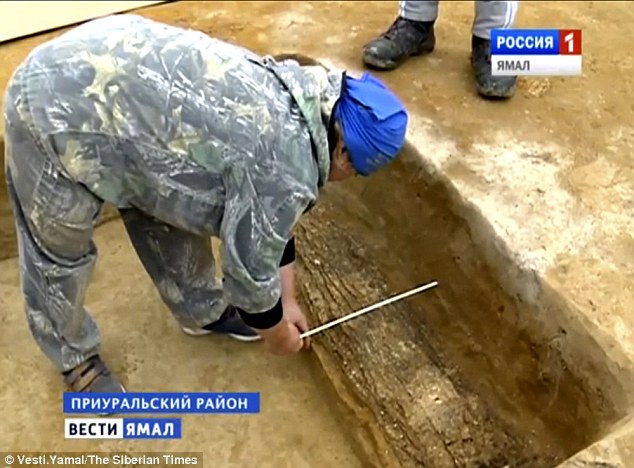
These images captured by local television crews from broadcaster Vesti Yamal show archaeologists studying the bark wrapped remains before removing them so they can be preserved and examined in more detail (Photo source: Vesti Yamal, The Siberian Times).
Previously they found 34 shallow graves at the site and 11 bodies with shattered or missing skulls.
Five mummies were found to be shrouded in copper and elaborately covered in reindeer, beaver, wolverine or bear fur. Among them was a female child whose face was masked by copper plates.
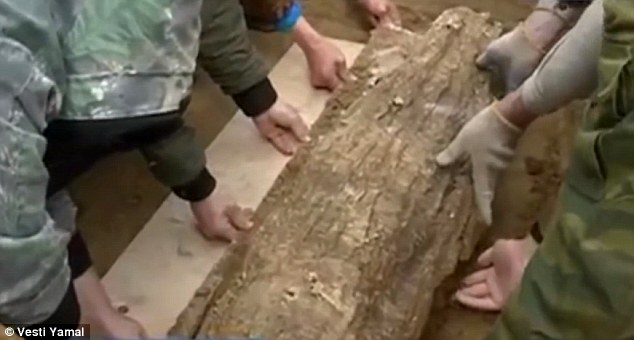
The bark cocoon (above) appears to have been wrapped around the body of a child or teenager. Experts also used metal detectors and found there is metal – possibly copper – inside covering the well preserved body (Photo source: Vesti Yamal, The Siberian Times).
Three male infants, also shrouded in copper masks, were also found nearby. They were also bound in four or five copper hoops.
A red-haired man, protected from chest to foot with copper plating and buried with an iron hatchet, furs and a bronze head buckle depicting a bear was also found at the site.
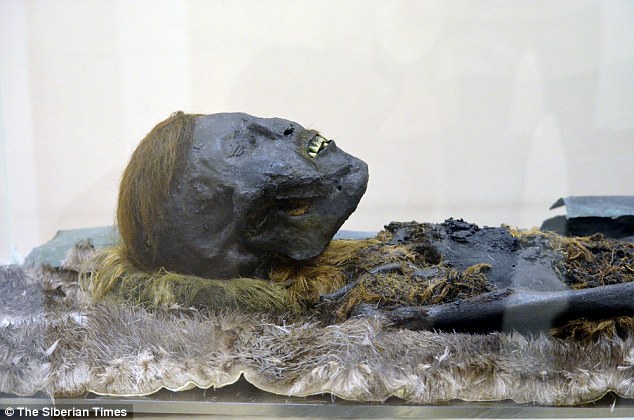
Five other mummified bodies have been found at the mysterious Zeleny Yar site, including the red headed man above who was found covered in copper plating and buried with an iron hatchet and covered in furs (Photo source: The Siberian Times).
Geneticists who have used DNA from the bodies recovered from the site recently revealed that their mitochondrial DNA appeared to match those of modern populations living in West Siberia.
Natalia Fyodorova, from the Ural branch of the Russian Academy of Sciences said previously about the discoveries:
“Nowhere in the world are there so many mummified remains found outside the permafrost or the marshes. It is a unique archaeological site. We are pioneers in everything from taking away the object of sandy soil (which has not been done previously) and ending with the possibility of further research.”
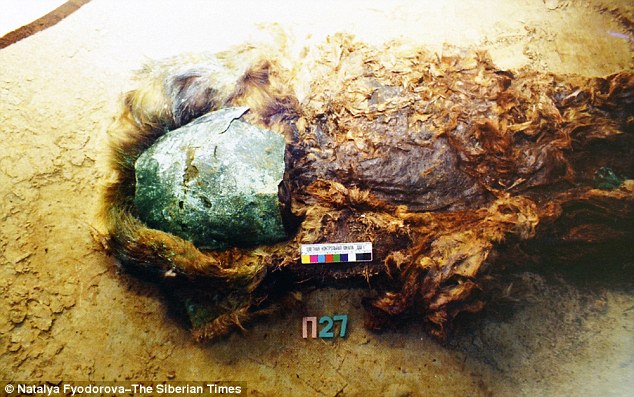
This copper facial mask was found on one of five other mummified bodies discovered at the Zeleny Yar site (Photo source: Natalya Fyodorova, The Siberian Times).
Artifacts found at the site, including bronze bowls, have led experts to conclude the people had links to Persia, some 3,700 miles to the south-west.



